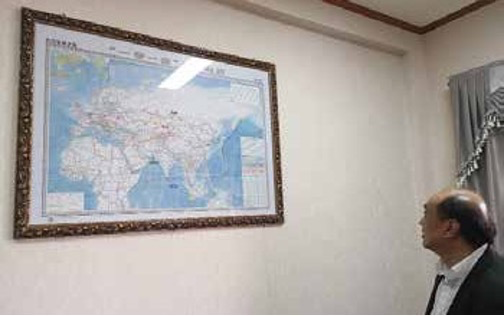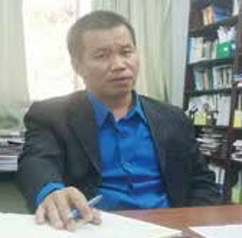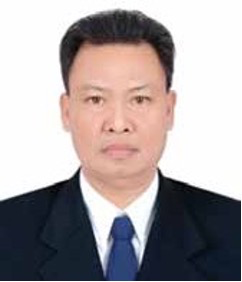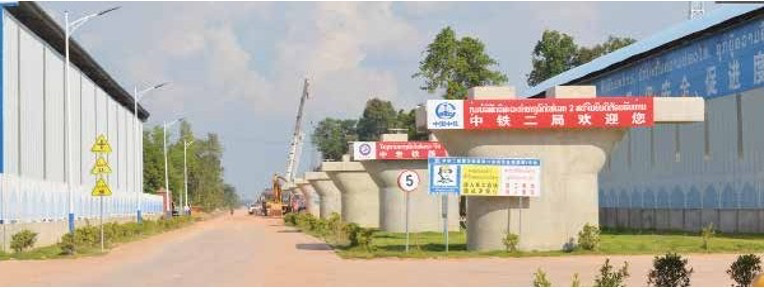

China's Belt and Road Initiative (BRI) is expected to be a key factor in converting Laos from a landlocked to a land-link country and driving a skyrocketing economy.
The initiative is a concept of Chinese President Xi Jinping who has a far- reaching vision to open up China to the world through the Belt and Road Initiative - a strategic trade route linking the country to Asean, Africa, Europe and Latin America, according to Acting President of the National Institute for Economic Research in Laos, Dr Leeber Leebouapao.

Dr Leeber Leebouapao looks at the BRI roadmap.
Laos is one of the nations actively participating in this project and is very keen to seize this opportunity to develop BRI infrastructure with the aim of linking the country to others in the region and facilitating economic growth.

Acting President of the National Institute for Economic Research Dr Leeber Leebouapao gives an interview to Vientiane Times. – Photos Chanh
Lao economists believe that connecting the two strategic plans of the Chinese government's BRI and the Lao government's vision to transform the country from being landlocked to a land link is a very positive move for Laos' economy and integration, as well as for China.
Two mega projects are currently under construction in Laos to help forge these links, namely the Laos-China railway and the Vientiane- Boten Expressway. These are part of the BRI and will pass through Laos to link with other countries in Asean as well as regions in the globe.
Acting President of the National Institute for Economic Research, Dr Leeber Leebouapao, strongly believes the BRI will create favourable conditions for the Lao government to succeed in transforming the country from being landlocked to a land-link hub. This has the potential to boost economic growth through increased domestic production, services and foreign trade, as well as attract more foreign direct investment and enhance diplomatic relations.
One of the projects is the 414.332-km railway, with a construction cost of US$5.986billion. It runs from the Boten border crossing in northern Laos on the border of China's Yunnan province to Vientiane and will link with railways of other Asean countries. Trains will run at speeds of up to 160 km per hour. Construction of the railway began in December 2016 and is scheduled for completion and opening in December 2021.
The 460-km Vientiane-Boten Expressway, with an estimated construction cost of about US$1.3 billion, is divided into four sections: Vientiane- Vangvieng, Vangvieng-Luang Prabang, Luang Prabang-Oudomxay, and Oudomxay-Boten. The expressway will link to railway stations.
Work on the first section from Vientiane to Vangvieng over a distance of 109.12 km is currently underway, with a vehicle speed limit of 100 km per hour. Construction of the whole expressway is expected to take three years.
Dr Leeber is confident that when these BRI projects are complete they will offer Laos great opportunities by acting as a springboard to stimulate tourism, production, investment, transit services, and access to a larger global market.
When Laos has improved logistics and lower transport costs, this will be attractive to investors because they need not have so many concerns about transport-related problems. At the same time, products made in Laos will have more competitive prices in overseas markets. And businesses and travellers will have more options when it comes to shipping goods and making travel plans after the railway becomes operational.
The Belt and Road Initiative is expected to improve the transit of goods through Laos as the expressway will be the closest route between China and Asean. At the same time, the railway in Laos will connect with railways in other Asean countries such as Thailand and Malaysia and then link up to Singapore.
But what Laos needs to do is to improve transit services as Singapore has done and improve local import-export and other services, Dr Leeber suggested.
In addition to infrastructure development, the governments of Laos and China have signed a memorandum of understanding on economic corridor cooperation in many areas such as the construction of large economic zones in Luang Namtha, Luang Prabang province, the north of Laos and Vientiane, the capital city of Laos as well as build large towns in these locations.
They also plan to cooperate in the provision of logistics services from the north of Laos to Vientiane, as well as electricity generation, the processing of farm produce, finance and banking, the environment, science, improvement of living conditions, job creation and information technology.
Collaboration in economic corridors is fundamental in supporting the Belt and Road Initiative. But the most important consideration for Laos is to use the expressway and railway in the most optimal way. With such an extensive transport system at its disposal, there is the potential to significantly upscale production so that output is greatly increased, resulting in greater economic efficiency, Dr Leeber said.
He projected that Laos will start to see a skyrocketing economy from 2026 onwards. The railway will be completed in 2021 and 2021-2025 will be a time of testing its utilisation and building essential infrastructure. At this point in time economic returns will not be high because the railway will have only just opened. The years 2026- 2030 will be a time of peak growth, when the best use is made of the railway. In addition, the development of economic zones, cities and other infrastructure will have been completed.
It is the Lao government's wish for the country to be a middle-high income nation by 2030. To reach that point, annual per capita income should be at least US$6,000, an increase of more than US$1,000 from the present time. The success of all forms of economic infrastructure are the building blocks to achieve this.
Dr Leeber said "It might seem like a dream but it can become reality because Laos has the necessary supporting conditions."
"The government fully supports the BRI because the Laos-China railway is a huge and historic project which is a turning point in our development. This has the potential to link Laos to other regions," he added.

Associate Professor and Vice Dean of the Faculty of Economics and Business Management at the National University of Laos, Dr Phouphet Kyophilavong, talks to Vientiane Times.
In the long term, Laos will have improved transportation and low-cost logistics and can expect a lot more foreign direct investment. But Laos must find ways to attract high- quality investors and increase its trade value, because other countries have the same goal and is competing in this field. Associate Professor and Vice Dean of the Faculty of Economics and Business Management at the National University of Laos, Dr Phouphet Kyophilavong, said "I think we need to provide a better environment for trade and investment. The government is doing its best such as by organising business forums to find ways to remove obstacles to doing business. Forums are a way to encourage ministers to be more active."
Dr Phouphet believes Laos can attract a lot of investment if the conditions are right, but said this depends on domestic reforms because we must understand that many other countries also want to attract foreign direct investment.
Businesses in Laos support the BRI because it will bring positive changes for Lao society as a whole, provide good conditions for business operations, and be a driver of economic development.

Chairman of the Chengjueter Development and Service Company, Mr Khamlek Chengjueter.
Chairman of the Chengjueter Development and Service Company, Mr Khamlek Chengjueter, who is an Executive Board Member of the Luang Namtha province Commerce and Industry Chamber, says the BRI will greatly benefit Laos and other countries through which the new infrastructure network will pass.
It will certainly boost development, transport, tourism and agriculture in Laos because the current transport limitations will be removed and it will be much easier for Lao goods to gain access to global markets.

A section of the Laos-China railway under construction in Vientiane.
--Readers can reach the author at chanfeature@ gmail.com